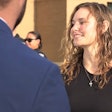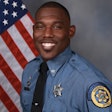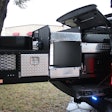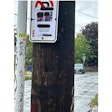The first body was found on Dec. 13, 1989, by a pair of men searching for junkyard scrap to sell. Near the refuse they noticed a buzzard, its attention captured by a shape beneath a torn piece of carpeting. When they moved the carpet they discovered the partially decomposed body of Richard Mallory. He was naked from the waist up, and his pants pockets had been turned inside out. The buzzard had been gnawing on his hand.
In a wooded area off Highway 19, in Citrus County, Fla., David Spears' lifeless body was found on a dirt road. It was June 1, 1990, and the 43-year-old Winter Garden construction worker had been missing since May 19. All he was wearing was a baseball cap. A used condom was found nearby.
Almost every month brought a new grim discovery. All of the victims were middle-aged white males and most had jobs that required travel along central Florida's highways. Each one of them had been killed with a small-caliber pistol. In most cases, there were signs of robbery, and for a few, recent sex.
On a humid Fourth of July day in 1990, a Pontiac Sunbird belonging to Peter Siems, a man who had been missing for nearly a month, crashed through a fence near the Seminole Indian Reservation. Despite the fact that one of the vehicle's occupants was injured, they refused all offers of help and fled the scene. One of them left behind a bloody palm print, and witnesses were able to describe the two women, later determined to be Aileen Wuornos and Tyria Moore.
Tracing the Past
Aileen "Lee" Wuornos was born into a hard life in Colorado. Her parents were teen-agers who had separated before she was born. Her father had been incarcerated for sodomizing a 7-year-old girl. He later committed suicide in prison.
Wuornos' mother abandoned her in infancy, leaving her to the care of her sister Lori and her grandfather. She was 13 before she learned that the woman raising her wasn't her mother.
Although family members described a fairly normal, lower-middle-class upbringing, Wuornos portrayed it as a life of hell. She described her grandfather as an abusive alcoholic, who beat her sadistically with a belt "just for kicks."
When, as a teen-ager, she was raped and left pregnant, Wuornos claimed her relatives never believed her version of the attack and called her a whore. She entered a home for unwed mothers, and the child was later given up for adoption.
At age 15, Wuornos traded her hard life at home for the dangerous world of the streets. She started drinking and taking drugs. And she slept in abandoned cars or wherever else she thought she'd be safe. Security was rare-Wuornos recalled being raped at least five more times before her 18th birthday. What wasn't taken from her, she sold to pay for motel rooms and bar tabs. Most of her income came from prostitution, a career that would span nearly 20 years.
In her early 20s, Wuornos married a 70-year-old man. But the marriage was short lived. During the divorce proceedings, her husband countered Wuornos' claims of physical abuse with his own fears of assault.
After her divorce, she drifted through several relationships and was caught robbing a convenience store. She later said that she'd committed the crime to see if the man she did it for loved her enough to bail her out. He didn't. She was arrested less than an hour after the crime and spent the next two years in prison.
In 1984, she moved to Florida and had her first lesbian relationship. Her lover eventually stole her money and left her with a $400 phone bill. Worse still, the two had had moderate success in a pressure cleaning business. Eventually the business failed, and she turned to prostitution.
In 1986, at a gay bar in South Daytona, Wuornos met Tyria Moore, who later became her "wife." Moore may have looked tough but she had been dependent on others all of her life. She spent her days relaxing by motel pools near the rooms they rented by the week. While Wuornos hooked to support them, Moore watched television.
Everything changed in late 1989.
The Killing Starts
Richard Mallory, 51, was a Clearwater electronics repair shop owner with a penchant for strip clubs and sleazy bars. Sometime on Dec. 1, 1989, he picked up a blonde woman with a rough voice and a face to match.
All that is known is that he left 1-4 and drove his 1977 Cadillac Coupe de Ville to a deserted area.
What happened next is speculation. It started as a simple transaction-sex for money, according to Wuornos, whose version came out in a police confession more than a year later. Wuornos claimed Mallory became abusive and the two fought. During the struggle she managed to extract her .22-caliber pistol from her purse and fire a single shot.
Mallory moved back, injured but still very much alive. In her confession, Wuornos recalled to police: "I thought to myself, well hell, should I, you know, help this guy or should I just kill him?" For a moment she just watched the injured man bleed. He was still alive and still a threat.
"So I figured, well if I help the guy and he lives, he's gonna tell on me and I'm gonna get arrested for attempted murder and all that jazz. And I thought, well the best thing is to keep shooting him." She shot him three more times. Wuornos then carefully covered Mallory's body with a piece of carpet and drove off in the dead man's Cadillac.
That night, in a motel parking lot, she showed the car to Moore and displayed Mallory's valuables. Wuornos also told her that she'd killed a man. Moore remembers being scared but she didn't come forward with what she'd learned until much later. She tried to keep her companion from ever discussing it again.
The first killing was the hardest, said Wuornos. In her mind she'd killed Mallory in self defense. But some mental health experts saw Wuornos' initial murder in a different light.
"Perhaps these men were especially violent in some way. It could be something they said or did, or something they reminded her of," said psychologist Phyllis Chesler in an interview with "Vanity Fair" magazine. "There could well be a violent man in her past with whom she had such an experience, (and) under certain conditions years later she found a way to respond. In a way, Mallory had been the conduit for her rage."
Her rage grew and she killed a second victim, David Spears. "I shot him through the door, and then he kind of went back and I went right through to the driver's side and shot him again and he fell back," Wuornos said, describing the murder.
Charles Carskaddon, a 40-year-old part-time rodeo worker, became another victim. "He said, 'You bitch, I'm gonna die' ... And I said, 'I guess you are, you son of a bitch, because you were gonna kill me anyway,'" said Wuornos. Carskaddon's body was found in Pasco County on June 6.
Troy Burress, a sausage salesman was reported missing July 31, when his abandoned delivery truck was discovered in the Ocala National Forest. Four days later, his badly decomposed body was found by campers.[PAGEBREAK]
Comparing Notes
By late August, Marion County Investigator John Tilley was nearly out of leads on the Troy Burress case, when a state crime bulletin sparked an idea, Citrus and Pasco counties had both reported cases of men whose bodies had been found in the woods. On Sept. 6, he met with Jerry Thompson, who was handling the Spears case, and Tom Muck, who was heading up the Carskaddon investigation, The trio compared the crime scenes and the killer's modus operandi. The connection was obvious.
But their knowledge didn't stop the killings. On the afternoon of Sept. 11, Charles Humphrcys, a retired Air Force major, former police chief and Florida State investigator. found his training little help against a gun-wielding killer. The 56-yearold, whose body was found in Marion County, was shot seven times.
The investigation heated up, and Ocala, the largest city in Marion County, became the hub. Police efforts were coordinated by Sgt. Bruce Munster, who had his own theory on the killer.
Munster's experience led him to believe it was a significant lead that the victims were shot primarily in the body, as opposed to the head. He believed male killers went for the head shots, and that women aimed lower. The Fourth of July car crash reinforced Munster's conviction.
On Nov, 19, a seventh body was found, that of Walter Gino Antonio. He had been shot four times and was left wearing nothing but tube socks.
The police went to the media and released a composite sketch based on the descriptions given by eyewitnesses to the July 4 crash.
"We don't normally go to the press." Munster explained. "But we felt we had a responsibility to warn the public of the danger in picking up female hitchhikers or females posing as women in distress." It also helped them capture the killer.
End of the Road
Jan. 9, 1991, was another in what had been a series of bad days for Wuornos. Moore had returned from a Thanksgiving trip just long enough to collect her belongings and return the diamond ring her lover had given her as a wedding band. Moore didn't explain her reason-that she had seen news reports describing the search for a female serial killer. The composite picture they showed could have been a snapshot of her and Wuornos,
The break-up sucked out whatever life was left in Wuornos. She started drinking earlier and tried her best to remain anesthetized all day, She found herself unable to prostitute, unable to do anything more than drink and sleep, She pawned the ring for $20.
When the money ran out, she slept on an abandoned car seat outside The Last Resort, a grim Daytona Beach biker bar where she tried to drown her pain. On Jan, 9, when two men offered her a $20 motel room she was eager to accept it. She was broke, drunk and homeless.
Outside the bar, half a dozen men in suits surrounded her. They had followed hundreds of leads-from the motel owner who recognized the composite, to a thumb print that Wuornos had given when she had pawned Mallory's camera. Wuornos journey was over, but the state's was just beginning.
Nearly a year passed before Wuornos stood trial for the murder of her first victim. In Deland, Fla., on Jan. 13, 1992, a Volusia County courtroom played host to the media and the curious, all of whom were there to see if the defendant being described as the country's "first female serial killer" would receive the death penalty.
The prosectuion knew they had a strong case. They had physical evidence, including fingerprints and buts from Wuornos' cigarettes that had been found in the victims' cars. They had pawn shop tickets she had traded for her victims' belongings and a storage bin she'd rented that held more of the dead men's possessions. They had also lined up more than 312 potential witnesses.
Among those who cam in contact with Wuornos was a neighbor who had filed a police report after the accused killer threatened her husband's life.
There was also a University of New Hampshire chemistry professor who'd picked up a suitcase-toting hitchhiker on U.S. Highway 19, just a few miles away from where the body of David Spears had been discovered. The professor said he'd let the stock blonde out when she began acting "crazy." The prosecution hoped that their testimony, along with that of various experts, would persuade the seven-woman, five-man jury that Wuornos wasn't a victim. She was a cold-blooded killer who murdered for money after selling sex. [PAGEBREAK]
Lover Steps Forward
In addition to all of the eyewitnesses and crime scene descriptions, there was one witness in particular that the prosecution was counting on-Tyria Moore. But the state's star witness was tainted by rumors of her own six-figure movie deal and a question that was on the minds of many. Was Moore just a guilty accomplice who had cut a deal and was willing to lie to avoid punishment?
On the fourth day of the trial, Moore's name was called. She strode to the witness box wearing a flashy, embroidered shirt and cowboy boots. If the courtroom had become restless during days of expert testimony, its attention was recaptured by Moors appearance. As Wuornos' lover of more than four years, only she could describe the accused's state of mind during the murders.
Moore and Wuornos had seen each other only once since the arrest. But in the courtroom, the long-time companions avoided eye contact. It was only during her most damning testimony that Moore allowed her gaze to stray. The two briefly looked at each other, and while Moore recalled her last months with Wuornos she offered the defendant a weak smile.
Wuornos had asserted that she had killed Mallory in self defense. But Moore had later been her confidant and had a different story.
Quietly, Moore described to the packed courtroom how Wuorno had come back to their hotel room on that December evening, telling her that she had just shot a man. Moore testified that she refused to believe her and tried to change the subject. But as the two watched television, Wuornos continued to deserve what had happened. And, according to Moore, there was never any mention of a confrontation or self defense. Nor did Moore see any sign of remorse.
The court allowed into evidence taped phone conversations made between Wuornos and Moore. While Wuornos was in prison, 11 calls were recorded during a three-day period in January 1991. Believe that she was speaking with complete privacy, the accused killer offered Moore absolution and a confession. Don't worry, she said, "I'll take the rap."
Assistant Public Defender William miller tried to discredit the state's star witness. But despite his best efforts, he could only get Moore to admit having discussed film and book rights with police investigators and lying to Wuornos about the nature of the taped conversations.
While Wornos' victims couldn't testify against her, the evidence they left behind surely did. In a move that had the defense team angrily demanding a mistrial, prosecutor John Tanner introduced evidence from the other murders.
Stephen Siems, whose father Peter was one of the victims, took the stand. Although Wuornos wasn't yet on trial for that crime, Siems wasn't yet on trial for that crime, Siems as introduced to illustrate a criminal pattern to the jury. Prosecutors didn't just want the defendant seen as a murderer. They wanted her recognized as a serial killer.
Stephen Sims carefully identified items that police had found in a rented storage bin at Jack's Mini Warehouse in Daytona Beach.
The key that opened the bin had been in Wuornos' possession the day of her arrest. When police investigator William Schwoob opened it, the items he uncovered matched the descriptions of those taken from Siems, Spears and Humphreys.
Siems began by identifying his father's license plate. 'and then a shaving kit. jackets. a suitcase and a pair of scissors. He pointed to the shears, and then the 24-year-old mechanical engineer quietly identified them as the pair his father had once used to cut his hair.
Lake County Medical Examiner William Schitz testified on the similarity of the deaths of Mallory and Burress. Both had been shot in the chest with a .22-caliber gun.
The Killer Takes the Stand
Wuornos wasn't expected to testify. Her own lawyers were concerned with their client's ability to control her emotions and not entrap herself. But on the last day of the trial, Wuornos took the stand in her own defense. They wouldn't say why-perhaps they had run out of other options.
Assistant Public Defender Tricia Jenkins gently questioned Wuornos and allowed the defendant to describe a scene in which she was the victim. In many ways her descriptions that day differed markedly from the ones she'd given the police in a videotaped confession a year before.
The way Wuornos told it. Mallory had wanted more than just sex. He'd wanted pain, In graphic detail, the accused murderer described how the 51-year-old video repairman an ally raped her and tied her to the steering wheel of his car. She told of how he used rubbing alcohol to intensify her torment. And then, as he began to have sex with her, Mallory tried to strangle her with a piece of electrical cord.
In her version, it was the fear of death that led her to somehow escape her captor's bonds. extract the .22-caliber pistol she always kept in her purse and aim it at Mal100Y, A shot was fired, Despite his wounds, Mallory advanced on her, "Don't make me shoot you again'" she said, But despite the threat he continued to come toward her, "He started coming at me and I shot .. · Wuornos told the courtroom, explaining why she shot him three more times,
Why would she take the trouble to conceal Mallory's body if she had killed him in self defense?
"I didn't want the birds to be pecking at his body'" she said,
Why hadn't she mentioned the rape in the course of her videotaped confession?
"That may be what I said, but that's wrong because I was totally incoherent ... ' she said, attributing her state of mind to alcohol withdrawal. She also assailed that if the detectives questioning her hadn't cut her off she would have spoken about the torture she'd suffered at Mallory's hands. Besides, she said, she was hysterical.
"I'm trying to tell the truth today, what actually happened'" she said to the court.
"Hard to keep the stories straight isn't it? Tanner asked sarcastically.
The defense objected strenuously. During their client's testimony, the defense made sure she didn't answer questions about the other murder cases.
That afternoon, the defense rested. Against the dozens of witnesses who came at the prosecutions behest, the defense only provided the testimony of Wuornos,
Jury Says Death
On Jan. 27. 1992. after listening to closing arguments, the jury returned from 90 minutes of deliberation. It was just a few minutes before 6 p.m, when Aileen Wuornos heard the foreman's words: "Guilty'"
"Sons of bitches," Wuornos swore at the same 12 people who would decide if she would live or die. In Florida, capital cases continue after the verdict in a penalty phase. Jurors hear evidence and arguments from both sides in order to decide for life in prison without parole for 25 years, or the electric chair.
The next day, jurors listened to a fingerprint expert, a corrections officer and a police investigator-all of whom were there to support the state's claim that Wuornos was a cold-blooded killer who deserved execution. But a psychologist for the defense argued that the killer's traumatic childhood mitigated her actions.
The jury wasn't swayed by the defense's statements and recommended death. Judge Blount, who had the option of ignoring the jury's decision, agreed with their assessment. On Jan. 31 1992, Aileen Wuornos was sentenced to death.
Once she received the death sentence for her role in Mallory's death. her remaining trials were almost anti-climactic. As far as Wuornos was concerned, it was over.
In jail she became a self-described, born- again Christian. She decided to forego the next trial for the murders of Humphreys, Burress and Spears. And instead of pleading her case before judge and jury, she retained new counsel-Steve Glazer. A flamboyant musician with a law degree, Glazer represented her as she pleaded "no contest." which while not admitting guilt, fast forwarded the proceedings.
Her former attorney, Assistant Public Defender Billy Nolan, called the decision "unconscionable" and criticized Glazer.
A jury, assembled solely to determine Wuornos' punishment, sentenced her to death after five hours of deliberation on May 7, 1992.
Less than a week later, Circuit Judge Thomas D. Sawaya upheld the jurors' recommendation. ''Thank you," Wuornos said. 'Ill be up in heaven while you all rot in hell."
Throughout the rest of 1992 and into the next year, the sentences continued to come in. In the end, Wuornos was also sentenced to death for the murders of Antonio, Carskaddon and Siems.
For a woman who has been running most of her life, Wuornos' race may soon be over. Mandatory appeals have been filed, but she could be executed as early as 1996. Although she shares her death row status with several other females, it's possible that Wuornos could be the first woman executed in Florida this century.
John Bankston is a freelance writer who initially covered this case for "The Advocate" magazine.












